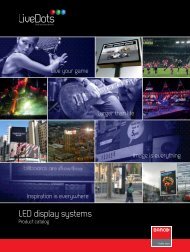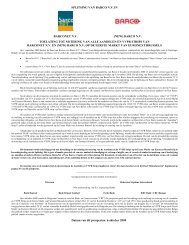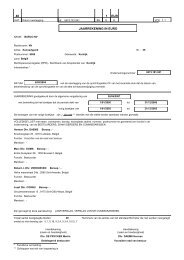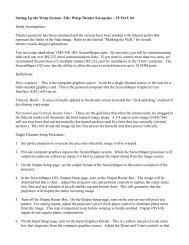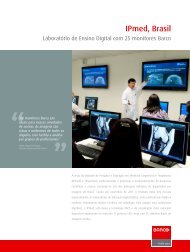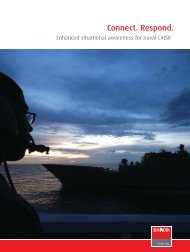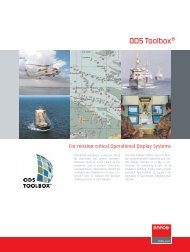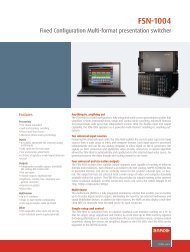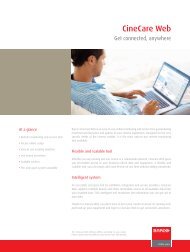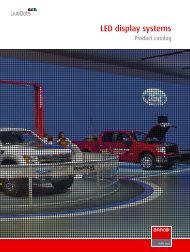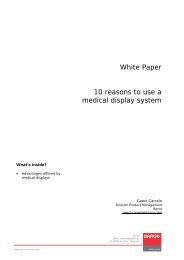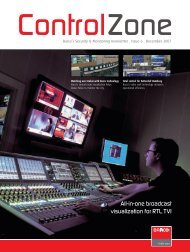MPR and 3D the most efficient way to read MDCT - Barco
MPR and 3D the most efficient way to read MDCT - Barco
MPR and 3D the most efficient way to read MDCT - Barco
Create successful ePaper yourself
Turn your PDF publications into a flip-book with our unique Google optimized e-Paper software.
The problem<br />
Too many images<br />
The development of 8 <strong>and</strong> 16-detec<strong>to</strong>r CT scanners has<br />
enhanced <strong>the</strong> quality of CT imaging by improving resolution<br />
spatially <strong>and</strong> temporally. However, this improvement<br />
comes at a price; <strong>the</strong> radiologist is now faced with <strong>the</strong><br />
daunting task of reviewing thous<strong>and</strong>s of images ra<strong>the</strong>r<br />
than hundreds.<br />
Film <strong>read</strong>ing now impossible<br />
Interpretation of <strong>MDCT</strong> studies presents new challenges for<br />
<strong>the</strong> radiologist. Reading film has become cost prohibitive.<br />
Even printing 36 images on one piece of film can generate<br />
50 sheets of film. Some radiology departments have considered<br />
printing every 4th image or ‘summing’ multiple<br />
images <strong>to</strong>ge<strong>the</strong>r <strong>to</strong> reduce <strong>the</strong> film burden. In addition <strong>to</strong><br />
<strong>the</strong> cost of printing film, <strong>the</strong> time required <strong>to</strong> interpret a<br />
large number of films has become a major burden for <strong>the</strong><br />
radiologist.<br />
X<br />
The solution<br />
Voxar <strong>3D</strong> enabled PACS<br />
<strong>MPR</strong> <strong>and</strong> <strong>3D</strong><br />
<strong>the</strong> <strong>most</strong> <strong>efficient</strong> <strong>way</strong> <strong>to</strong> <strong>read</strong> <strong>MDCT</strong><br />
The development of combined 2D <strong>and</strong> <strong>3D</strong> wo r kst ations<br />
permits <strong>the</strong> ra d i o l o g i st <strong>to</strong> inte r ro g ate <strong>the</strong> data in st a c k<br />
mode with real time cine. The addition of <strong>MPR</strong> allows <strong>the</strong><br />
radiologist <strong>to</strong> view <strong>the</strong> ana<strong>to</strong>my in any plane in real-time.<br />
T h ese images can be created live on <strong>the</strong> wo r kst at i o n<br />
without any need for te c h n o l o g i st pre- p ro cessing on <strong>the</strong><br />
CT console. Failing <strong>to</strong> view <strong>the</strong> dat a s ets created by <strong>MDCT</strong><br />
Conventional 2D PACS <strong>read</strong>ing is only a partial solution<br />
Although PACS viewing is a substantial improvement ove r<br />
film, it is an inco m p l ete solution. Cine rev i ew of <strong>the</strong> original<br />
axial slices presents only a fraction of <strong>the</strong> available info r m ation.<br />
Most pathology does not lie within <strong>the</strong> tra n sve r s e<br />
p l a n e. The increased spatial resolution of <strong>MDCT</strong> aids <strong>the</strong> production<br />
of high quality multiplanar re co n structions (<strong>MPR</strong>) in<br />
a ny plane. For <strong>the</strong> first time, CT has surpassed MRI as a truly<br />
multiplanar imaging technique; howeve r, only if <strong>the</strong> PAC S<br />
sy stem is capable of producing on-t h e-fly <strong>MPR</strong>.<br />
Difficult <strong>to</strong> communicate findings<br />
Radiologists typically employ two methods <strong>to</strong> communicate<br />
findings: a typed text-based report, or a summary<br />
series of images attempting <strong>to</strong> represent key pathology.<br />
Text-based reports do not adequately convey <strong>the</strong> complex<br />
ana<strong>to</strong>mical relationships of pathology. On <strong>MDCT</strong> scans,<br />
summary series may require duplication of dozens, if not<br />
hundreds, of images.<br />
in <strong>MPR</strong> mode eliminates <strong>the</strong> major a d vantage of <strong>MDCT</strong><br />
over single-s l i ce scanners: increased z-axis resolution <strong>and</strong><br />
i m p roved re co n st r u c t i o n s. Important findings which need<br />
<strong>to</strong> be communicated <strong>to</strong> <strong>the</strong> referring physician can now<br />
be re p res e n ted with a few <strong>3D</strong> or <strong>MPR</strong> i m a g es. Unlike<br />
routine 2D images, <strong>MPR</strong> <strong>and</strong> <strong>3D</strong> images are ea s i l y<br />
i n te r p reted by <strong>the</strong> referring physician <strong>and</strong> radiologist alike.
The problem<br />
• <strong>MDCT</strong> pro d u ces <strong>to</strong>o many images<br />
- Film <strong>read</strong>ing now imposs i b l e<br />
- Increased spatial resolution re q u i res <strong>MPR</strong> rev i ew<br />
• Sagittal <strong>and</strong> coronal <strong>MPR</strong> produced on a scanner<br />
console<br />
- Te c h n o l o g i sts time re d u ces scanner thro u g h p u t<br />
- <strong>MPR</strong>s fur<strong>the</strong>r increase image number<br />
- <strong>MPR</strong>s in <strong>the</strong> wrong plane re q u i re re p eat s<br />
• Co nve ntional 2D PACS is only a partial solution<br />
- Only presents axial images or console pro d u ced <strong>MPR</strong><br />
- Radiologist is unable <strong>to</strong> generate views in real-time<br />
- D i f f i cult <strong>to</strong> cro ss- refe re n ce spatial location bet ween<br />
<strong>MPR</strong> series<br />
• D i ff i cult <strong>to</strong> co m m u n i c ate findings<br />
- Demonst rating pathology may re q u i re production<br />
of large summary series or a montage view<br />
- Axial images not easily unders<strong>to</strong>od by surgeons <strong>and</strong><br />
o<strong>the</strong>r referring phy s i c i a n s<br />
- Text report <strong>and</strong> a few axial images cannot co nvey<br />
co m p l ex ana<strong>to</strong>mical re l ationships<br />
VOXAR is a registered trademark, <strong>and</strong> VOXAR <strong>3D</strong> is a trademark of <strong>Barco</strong> in Europe <strong>and</strong> o<strong>the</strong>r countries.<br />
K5906132 rev.00.02 © 2006 <strong>Barco</strong> 1106<br />
www.barcomedical.com<br />
Outside radiology<br />
Emergency room:<br />
PACS clinical<br />
review workstation<br />
Cancer board<br />
meeting room<br />
Operating room:<br />
PACS clinical review<br />
workstation<br />
Referring<br />
physicians room<br />
Remote locations<br />
Referring<br />
physicians home<br />
Radiologists home<br />
Local hospital<br />
network<br />
DSL<br />
cable<br />
The solution<br />
• VOX A R 3 D enabled PACS<br />
- Combined 2D <strong>and</strong> <strong>3D</strong> functionality<br />
- Technologists pre-processing available off <strong>the</strong><br />
scanner co n s o l e<br />
- Radiologist retains <strong>the</strong> ability <strong>to</strong> change<br />
te c h n o l o g i sts pre- p ro cessing using LI V E IM AG E S<br />
- Rea l -time cine in any plane<br />
( axial, sagittal, co ronal, oblique, cu r ve d )<br />
- On-t h e-fly <strong>MPR</strong> <strong>and</strong> <strong>3D</strong> image generat i o n<br />
- <strong>MPR</strong> <strong>and</strong> <strong>3D</strong> re d u ce <strong>the</strong> number of images<br />
n e cessary <strong>to</strong> co nvey findings <strong>to</strong> referring phy s i c i a n s<br />
Technologists post-processing<br />
workstation<br />
Radiologists<br />
office<br />
Radiology<br />
PACS archive<br />
M D C T, MRI<br />
<strong>and</strong> PET<br />
Reading room:<br />
PACS diagnostic<br />
workstation<br />
Ba rco (Belgium)<br />
P res. Kennedypark 35<br />
B-8500 Ko r t r i j k, Belgium<br />
Phone: +32 56 233 557<br />
Fax: +32 56 233 374<br />
E-mail: sa l es. m e d i c a l . e u @ b a rco. co m<br />
Ba rco V i ew, LLC (USA )<br />
3059 Pre m i e re Pa r k <strong>way</strong> - Duluth<br />
G e o rgia, 30097- 4 9 0 5, U SA<br />
Phone: +1 678 475 8000<br />
Fax: +1 678 475 8237<br />
E-mail: sa l es. m e d i c a l . u s @ b a rco. co m<br />
Ba rco LT D. ( Ta i wa n )<br />
17th fl o o r, Ku o hwa Building<br />
8 6 8-6, Chungcheng Ro a d ,<br />
C h u n g h o C i t y, Taipei Co u nt y, 235, Ta i wa n<br />
Phone: +886 2 8221 6868<br />
Fax: +886 2 8221 6969<br />
For your local co ntact<br />
visit www. b a rco m e d i c a l . co m



